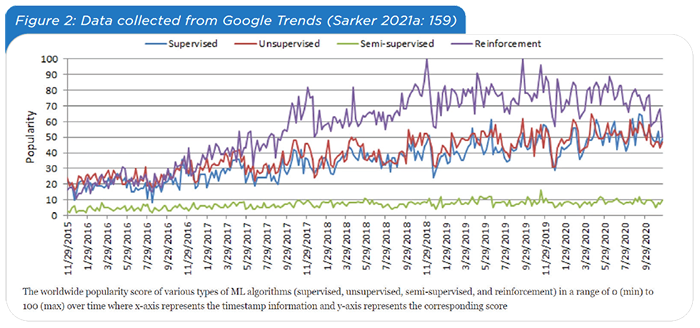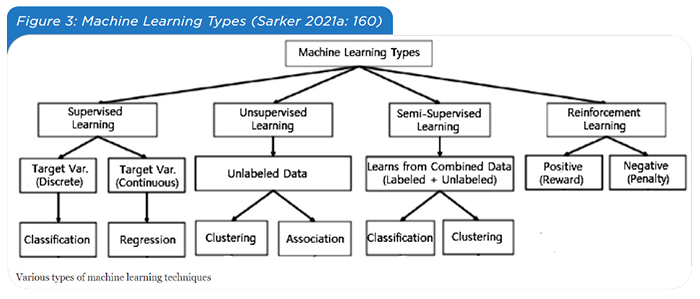Machine Learning (ML):
In recent years, Artificial Intelligence (AI), especially Machine Learning (ML), has experienced rapid growth in the realm of data analysis and computing. This evolution enables applications to operate intelligently. ML empowers systems to autonomously learn and improve from experience without the need for explicit programming. In the Fourth Industrial Revolution (4IR or Industry 4.0), namely the ongoing automation of traditional manufacturing and industrial practices, ML stands as one of the most prominent technologies. Instead of being explicitly programmed to perform a task, a machine learning system learns from data, thereby improving its performance over time. ML algorithms are thus considered the cornerstone for intelligently processing this data and creating real-world applications (Sarker, 2021a). These learning algorithms can be categorized into four primary types: supervised, unsupervised, semi-supervised, and reinforcement learning (see below). The popularity of these learning approaches has been steadily rising, as demonstrated in Figure 2.

Here’s a breakdown:
1. Types of Machine Learning (see Figure 3):
a. Supervised Learning: Supervised learning involves the machine learning process of acquiring knowledge from labeled input-output pairs to establish a mapping function. It relies on annotated training data and a dataset of training instances to deduce this function. Supervised learning is employed when specific objectives need to be achieved using a defined set of inputs, essentially adopting a task-oriented approach. The most prevalent tasks within supervised learning encompass “classification,” which segregates data, and “regression,” which models the data (Cunningham et al., 2008). For instance, predicting the class label or sentiment of textual content, such as a tweet or a product review, known as text classification, serves as a prime illustration of supervised learning.
b. Unsupervised Learning: Unsupervised learning delves into the analysis of unlabeled datasets autonomously, operating without human intervention—thus embodying a data-driven approach. It serves various purposes, including extracting generative features, uncovering meaningful patterns and structures, discovering inherent groupings within data, and facilitating exploratory endeavors. Among the prevalent tasks within unsupervised learning are clustering, density estimation, feature learning, dimensionality reduction, the discovery of association rules, and anomaly detection, to name a few (Ghahramani, 2003).
c. Semi-supervised Learning: Semi-supervised learning can be described as a fusion of the supervised and unsupervised approaches since it operates on both labeled and unlabeled datasets. Consequently, it occupies a middle ground between learning “without supervision” and learning “with supervision.” In real-world scenarios, labeled data can be scarce in numerous contexts, while unlabeled data abound, making semi-supervised learning particularly valuable (Zhu, 2005). The primary objective of\ a semi-supervised learning model is to deliver improved prediction outcomes compared to those achievable using only labeled data within the model. Semi-supervised learning finds application in various domains, including machine translation, fraud detection, data labeling, and text classification.
d. Reinforcement Learning: Reinforcement learning is a category of machine learning algorithms that empowers software agents and machines to autonomously assess the most effective behavior within a specific context or environment to enhance their performance. This approach is fundamentally driven by the characteristics of the environment itself. The model learns by interacting with an environment and receiving feedback (rewards or punishments) based on its actions, with the ultimate objective of utilizing insights gained from interactions with the environment to make choices that maximize rewards or minimize risks (Kaelbling et al., 1996). Reinforcement learning serves as a potent tool for training AI models, particularly in domains where automation enhancement and operational efficiency optimization are paramount. Such domains include robotics, autonomous driving systems, manufacturing processes, and supply chain logistics. However, it is not typically the preferred choice for addressing simple or straightforward problems.

For a detailed review of the main ML techniques, see here.
2. Various Applications:
- Predictive analytics (e.g., stock price prediction)
Predictive analytics powered by machine learning facilitates intelligent decision-making through data driven insights (Cao, 2017; Mahdavinejad et al., 2018). It uses relationships between variables from past data to forecast outcomes [Han et al., 2009]. AI models can predict future trends based on historical data, allowing industries to preemptively adjust strategies. In education (Choi et al., 2023; Lim et al., 2023), disease diagnosis (Khan, 2023; Kumar et al., 2022), specific research fields such as synthetic biology (Tong & Zhang, 2023), not to mention writing in academia (Perkins, 2023) and scientific fields (Ali & Djalilian, 2023), researchers are predicting how AI will affect various areas and using AI to predict research trends. Accurate predictions benefit various sectors, from government to healthcare, banking, e-commerce, and more. In the context of advertising, predictive analytics leverages AI and machine learning to target audiences and optimize ad placements, focusing on personalization and real-time content delivery. Image, speech recognition, and pattern recognition.
- Image recognition
Image recognition through machine learning (Fujiyoshi et al., 2019) is highly prevalent in real-world applications. Through image recognition one can identify objects in digital images. Labeling x-rays, character and face detection, and social media tagging are all examples of image recognition. Speech recognition (Chiu et al., 2018), used in platforms like Google Assistant and Alexa (López et al., 2017), leverages sound and linguistic models through machine learning. Pattern recognition (Anzai, 2012) automates the identification of data patterns using techniques like classification, clustering, and sequence labeling. In advertising, machine learning-enhanced image and speech recognition can be transformative, enabling advanced targeting and personalization. For instance, image recognition can be used for analyzing consumer behavior through social media imagery, while speech recognition powers voice-activated advertisements, offering interactive and tailored consumer experiences.
- Medical diagnosis
Machine learning aids in various medical tasks, from disease prediction to patient management (Fatima et al., 2017; Nilashi et al., 2017). For instance, in the case of Covid-19, learning techniques have been instrumental in classifying high-risk patients, predicting outbreaks, and understanding the virus’s origin (WHO; Kushwaha et al., 2020). Machine learning forecasted potential COVID-19 spread, guiding regions to prepare. Additionally, deep learning offers solutions in medical image processing. In advertising, the application of machine learning techniques used in medical fields, such as disease prediction and patient management, can be adapted for consumer health trends analysis and targeted health-related campaigns. For example, deep learning in medical image processing can inspire advanced visual analytics in advertising, enhancing ad personalization and effectiveness.
- Recommender systems (e.g., movie recommendations)
Machine learning powers product recommendations, a hallmark of modern e-commerce. It analyzes consumers’ buying patterns and preferences to personalize suggestions. By studying browsing trends and click-through rates, e-commerce platforms, like Amazon (Marchand & Marx, 2020), optimize inventory, logistics, and prevent stockouts. Machine learning enhances the shopping experience through tailored content and helps retain and attract customers.
- NLP and sentiment analysis
NLP enables computers to interpret and understand language (Otter et al., 2020). It powers applications like virtual assistants, chatbots, speech recognition, and machine translation. Sentiment Analysis, a subset of NLP (Ravi & Ravi, 2010), determines public opinion from sources like blogs, reviews, and social media. It helps businesses gauge brand or product sentiments, categorizing feedback as “positive”, “negative”, “neutral”, or other specific emotions. In essence, machine learning assists in extracting and categorizing these sentiments from text. In advertising, NLP and Sentiment Analysis enable advertisers to extract and categorize public sentiments from online sources like blogs and social media, providing insights into brand perception and guiding the creation of more resonant and effective advertising strategies. This application of NLP in analyzing feedback aids in tailoring advertisements to align better with consumer attitudes and trends.
